The John Day Fossil Beds Oregon (formally called the John Day Fossil Beds National Monument) is a special place full of adventure and history.
In this article, we’ll cover everything you need to know about visiting the John Day Fossil Beds. We’ll start with an overview of the John Day Fossil Beds in Oregon, including a helpful map.
Next, we’ll get you up to speed on the available hikes, viewpoints, accommodation, camping, and logistics of visiting this incredible national monument.
From the stunning Painted Hills to world-renowned fossil records and more hidden gems to uncover, the John Day Fossil Beds are a unique and memorable place.
Pack your sense of adventure and let’s take a trip to John Day Fossil Beds National Monument Oregon.
Overview of John Day Fossil Beds National Monument
The John Day Fossil Beds National Monument (also called John Day Park Oregon) is a remarkable destination in Central Oregon that preserves a rich and diverse fossil record spanning millions of years.
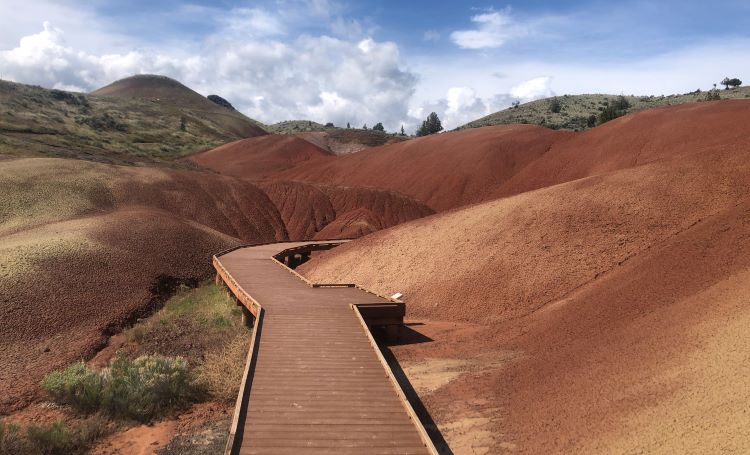
Visitors can explore world renowned hiking trails, view fossil exhibits, and witness the extraordinary beauty of the hills, rock formations, and wildlife.
This area of Central Oregon is remote, but there are still available amenities like restaurants, grocery stores, and accommodation. Also, you are not likely to encounter crowds during your visit.
Getting to John Day Fossil beds can take some time. The route from Portland to John Day Fossil Beds is typically a 4-hour trip. Bend to John Day Fossil Beds usually takes over two hours.
That said, keep in mind that the monument as a whole is a large area, and the three units are spread out with some drive time in between them.
Map John Day Fossil Beds
Use the John Day Fossil Beds map below to see all the hikes, campgrounds, lodging, and more. Expand the map to see the full list.
John Day Fossil Beds Units
There are three separate units in John Day Fossil Beds National Monument. Depending on your route, they are up to 2 hours apart. See the table below for drive times. Keep in mind, it is difficult to see all three units within a single day.
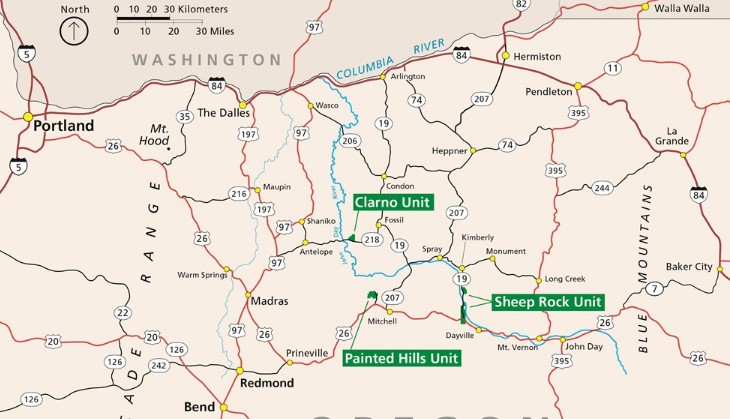
Distances & Drive Time Between Units:
| Sheep Rock to Painted Hills | 45 miles (1 hour) |
| Painted Hills Unit to Clarno Unit | 75 miles (1.5 hours) |
| Clarno Unit to Sheep Rock Unit | 81 miles (2 hours) |
As a result, it is recommended to allow two or three days to fully appreciate the entire national monument. Three days is ideal to give each unit a full day, though the Clarno Unit is the smallest and a half day is probably plenty.
That said, it is still worth a trip even if you just have one day. If you have only a few hours, we recommend you prioritize the Painted Hills Unit.
Painted Hills John Day Fossil Beds Oregon
The Painted Hills Unit is a captivating destination within the John Day Fossil Beds National Monument.
It is no wonder why it is the most visited unit, as it showcases a stunning array of colorful hills, painted with reds, yellows, golds, and blacks.
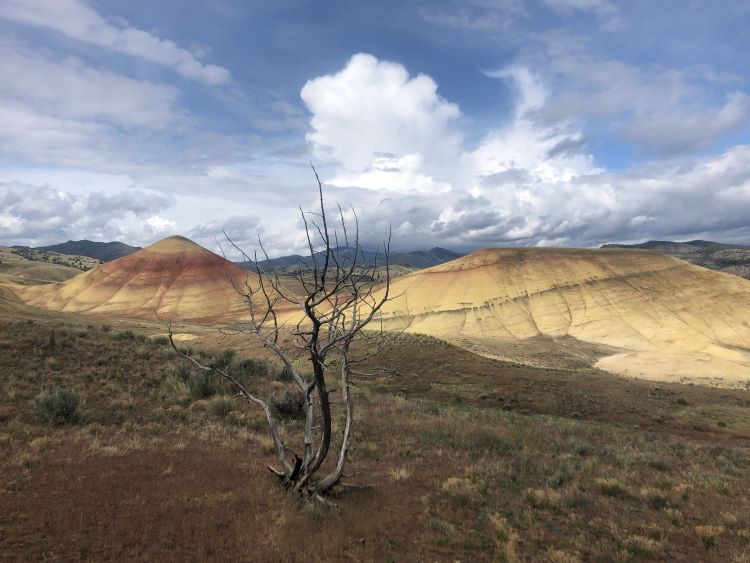
This unique landscape of the John Day Oregon Painted Hills preserves a record of past climate change and is adorned with leaf and animal fossils dating back millions of years.
With its ever-changing hues and remarkable formations, Painted Hills John Day Oregon offers visitors a mesmerizing experience and a glimpse into the ancient history of our planet.
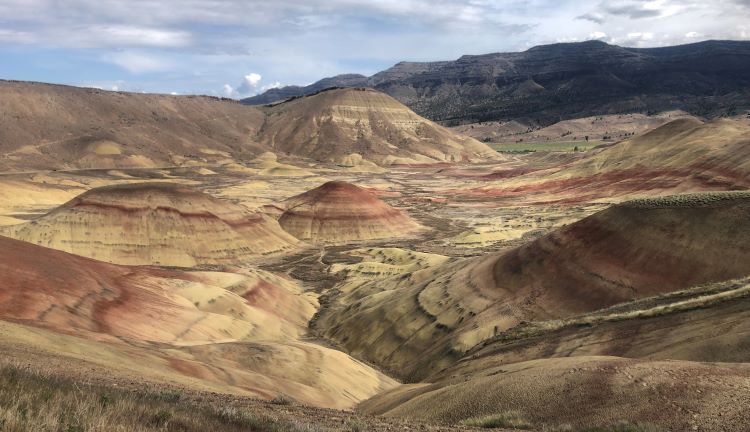
The colorful and bizarre hills do appear to be painted with bright red, yellow, and gold hues, then speckled with black dots. Trust us: they look way better in person!
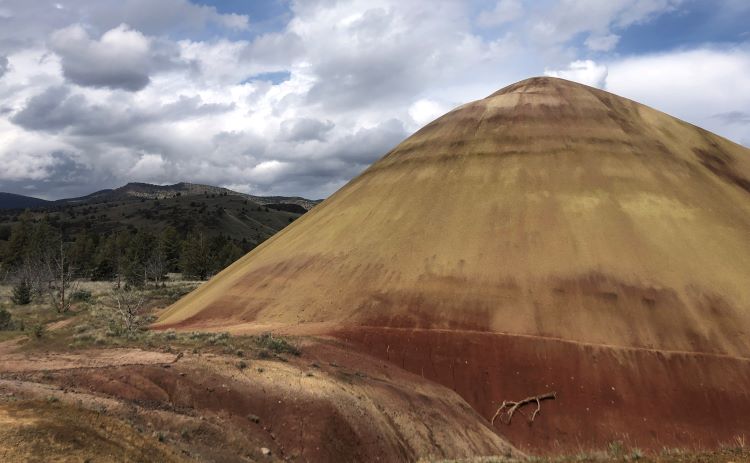
Painted Hills has five short hiking trails with plenty of excellent viewpoints. If you’re short on time, do the Painted Hills Overlook Trail and the Painted Cove Trail. If you have three hours or so, you can do all five hikes!
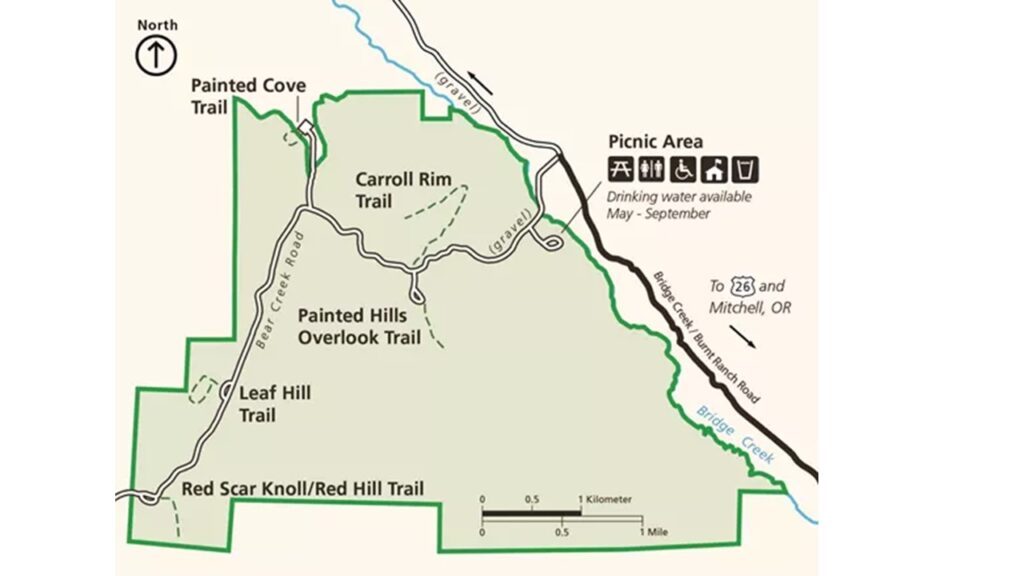
Painted Hills Tips
- Sunrise and sunset are the best times for photography
- Sunshine makes the colors on the hills pop (try to avoid overcast days)
- A recent rain will also make the colors more vibrant
- There is only one bathroom and it is at the entrance of the park on the left
- Take your time to read the educational signage
Learn more in our full article about the Painted Hills.
Clarno Unit Oregon John Day Fossil Beds
The Clarno Unit is a great place to see fossils and unique rock formations. The Palisades is an impressive series of volcanic lahar formations (fancy terminology for mudflows) that formed between 40 and 54 million years ago.
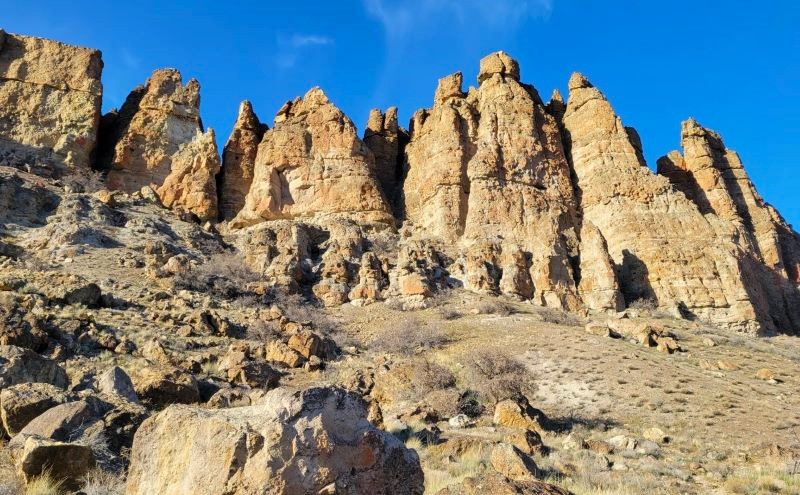
There are three short trails visitors can explore. These hikes are close together and can be done within 2 to 3 hours. The volcanic lahars (or mudflows) are incredible rock formations that are impressive in person and in photos.
You can actually see fossils embedded within the mud walls of the lahar formations! There is lots of helpful signage to help you understand the history.
The Clarno Unit is your best shot at seeing fossils “in the wild”. Don’t get me wrong, there are hundreds of fossils at the Thomas Condon Paleontology center (more on that in a bit). However, the Clarno Unit has fossils embedded into the walls of mudflows.

These fossils are mostly plants and super exciting to see in the same spot where they were deposited millions of years ago.
Sheep Rock Unit John Day Fossil Beds
The Sheep Rock Unit has more incredible geology consisting of unique, colorful, and ancient rock formations. There are several layers of fossils and even some older rock that has no fossils.
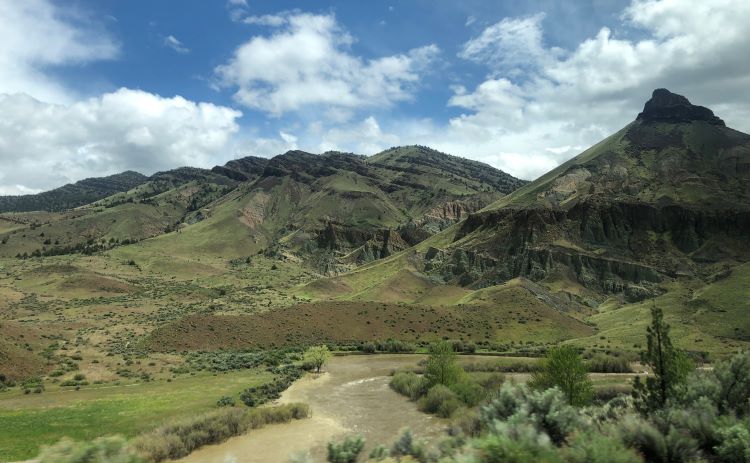
There are seven hiking trails in the Sheep Rock Unit and each one offers a unique view into this incredible landscape. In addition, these hikes are mostly short with a length between 0.25 to 3.25 miles.
It is important to note that the Sheep Rock Unit has a few sections scattered close by each other. You can explore most of this unit within 3 hours, but it is best to set aside an entire day if you can!
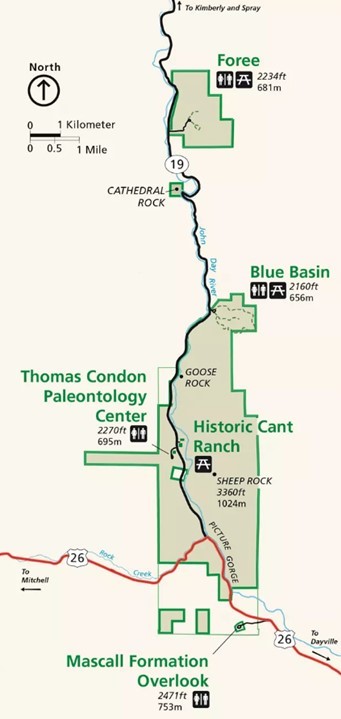
In fact, you can easily spend an entire day in this unit and there would still be more to explore. If you’re short on time, don’t miss the Blue Basin and the Thomas Condon Paleontology Center.
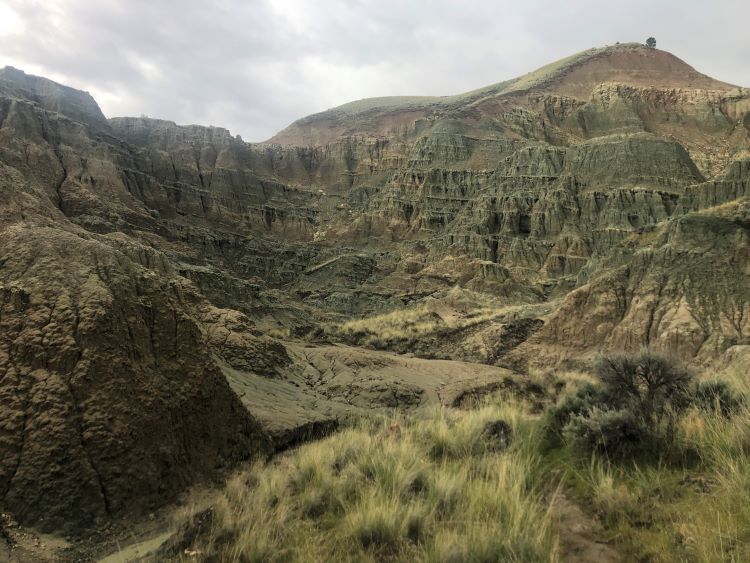
There are several unique layers of fossils from different time periods as well as rock without fossils that is even older. Before you go, learn more about the fossil records and geology in this unit.
Of course, you are not allowed to collect fossils as the landscape is sensitive to erosion. As always, you must practice leave no trace principles when exploring natural areas.
Thomas Condon Paleontology Center
The Thomas Condon Paleontology Center (often called the John Day Fossil Museum or the John Day Visitor Center) is a large and insightful educational center opened in 2005 and holds over 500 fossil specimens from the John Day Fossil Beds.
A cross between a museum and a laboratory, the center has tons of descriptive text and images to help you understand the history of this area.
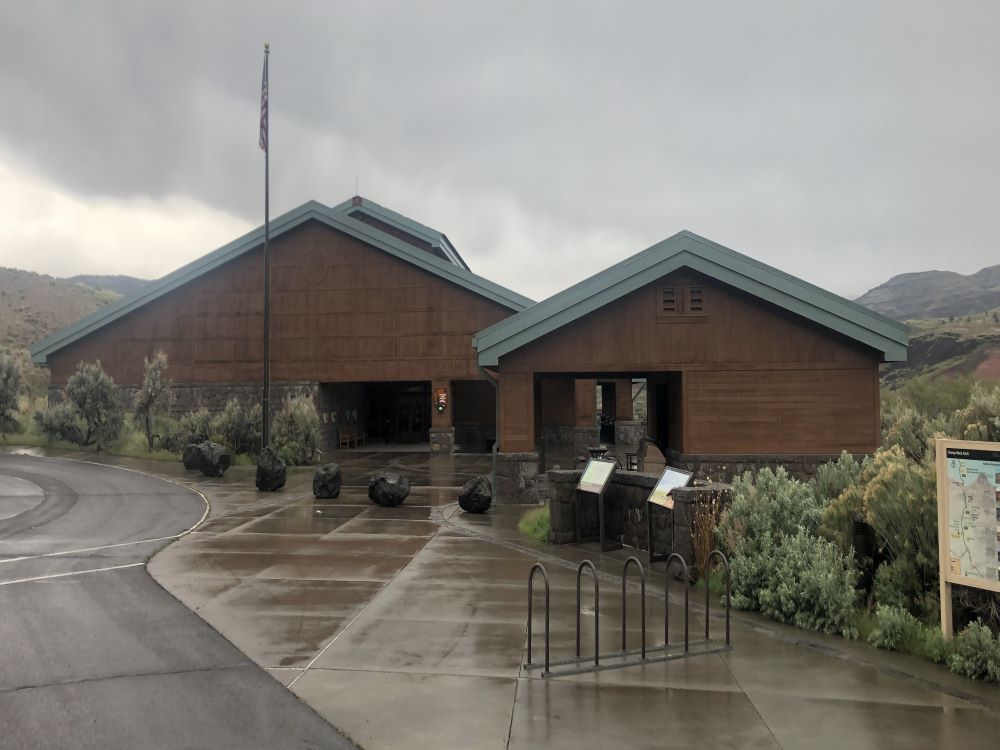
It is also fun to see into the laboratory over the shoulders of professional scientists as they work. In addition, there is a super helpful video that describes the rich historical events that led to the excellent fossil records that exist today.
Overall, the Thomas Condon Paleontology Center is a must see if you are in this unit!
Best Time to Visit John Day Fossil Beds
The best time to visit the John Day Fossil Beds is probably in the spring or fall. The high desert climate can be harsh, with bitter-cold winters and dry, hot summers.
Spring and fall offer more mild temperatures but still have lots of warm and sunny days. That said, weather can still be variable, so check the forecast.
Spring is often better as the landscape is greener from the rain and has blooming wildflowers on display.
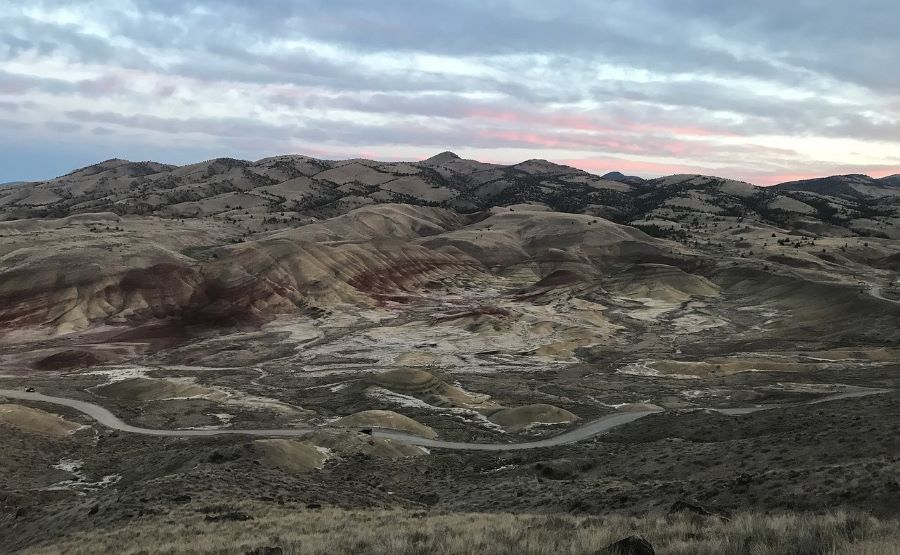
If you can, try to go right after a day or two of rain as the wet rock and dirt make the colors pop. The wildflowers and flora are also most productive right after some rain, especially in the spring.
Hiking John Day Fossil Beds
As we touched on already, there are three units within the John Day Fossil Beds, each with their own set of short hikes. These hikes are all fairly short, making it ideal to do all the hikes in a given unit within a few hours.

John Day Fossil Beds Hikes
| Hike | Unit | Length | Highlights |
| Painted Hills Overlook Trail | Painted Hills | 0.5 mile / 0.8 km | Views of the main painted hills area. |
| Carroll Rim Trail | Painted Hills | 1.6 mile / 2.6 km | Highest elevation viewpoint. |
| Painted Cove Trail | Painted Hills | 0.25 mile / 0.4 km | Intimate and immersive colorful hills. |
| Leaf Hill Trail | Painted Hills | 0.25 mile / 0.4 km | Interesting piles of slate rock. |
| Red Scar Knoll Trail | Painted Hills | 0.25 mile / 0.4 km | A quirky red colored hill. |
| Trail of Fossils | Clarno | 0.25 mi / 0.4 km | Best trail to see wild fossils. |
| Geological Time Trail | Clarno | 0.5 mi / 0.8 km | Connects Trail of Fossils and picnic area. |
| Clarno Arch Trail | Clarno | 0.5 mi / 0.8 km | Impressive arch view from base of Palisades. |
| Flood of Fire | Sheep Rock | 0.4 mi / 0.6 km | Fantastically unique rock formations and landscapes. |
| Story in Stone | Sheep Rock | 0.3 mi / 0.5 km | Same as Flood of Fire |
| Island in Time | Sheep Rock | 1.3 mi / 2.1 km | Greenish blue rock and sometimes a matching creek. |
| Blue Basin Overlook | Sheep Rock | 3.25 mi / 5.2 km | Great views of Blue Basin and surrounding landscape. |
| River Trail and Sheep Rock Overlook Trail | Sheep Rock | 0.6 mi / 1 km | A pleasant walk along the John Day River and historic ranch. |
| Thomas Condon Overlook Trail | Sheep Rock | 0.25 mi / 0.4 km | A nice view of the river value from above the visitor’s center. |
| Mascall Formation Overlook | Sheep Rock | 430 ft | A viewpoint of the area’s unique geology. |
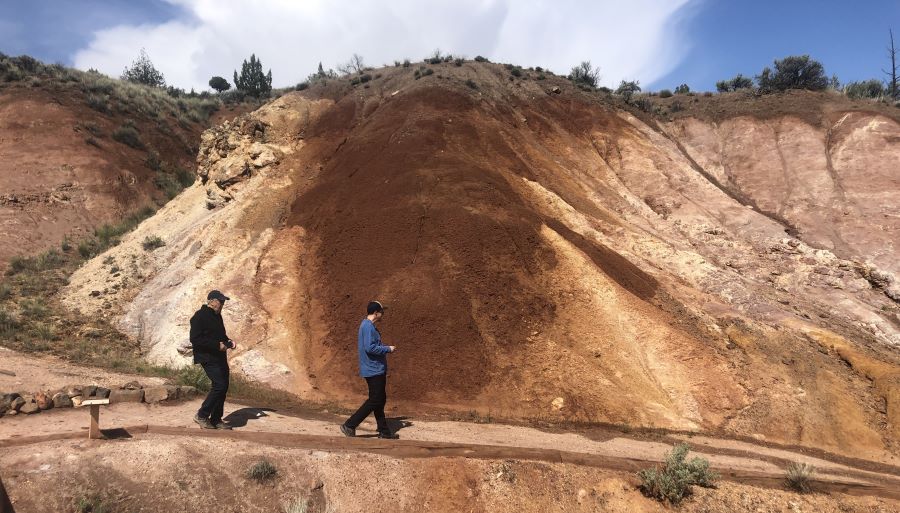
Camping John Day Fossil Beds
John Day Fossil Beds camping is plentiful and widespread. There are several free and dispersed camping options on BLM land in addition to paid campgrounds.
Keep in mind, the area is large. Fortunately, there are many campgrounds near John Day Fossil Beds to accommodate.
More Information About Campgrounds and RV Parks
There are dozens of campgrounds near John Day Fossil Beds, including a mixture of BLM, USFS, Oregon State Park, and privately owned options.
There are too many to fit in this article. However, the National Parks Service official website has an awesome page on camping nearby.
Lodging John Day Fossil Beds
There are several options for lodging near John Day Fossil Beds. Again, because the area is so large, it is important to plan your route and lodging accordingly.
Hotels John Day Fossil Beds
| Lodging | Location | Closest Unit | Description |
| Painted Hills Vacation Cottages and Retreat | Mitchell | Painted Hills | A highly rated, family-owned group of 4 cottages for up to 10 guests. Best for families and larger groups. |
| Spoke’n Hostel | Mitchell | Painted Hills | A highly rated hostel with great amenities. Ideal for cyclists and community atmosphere. |
| Skyhook Motel | Mitchell | Painted Hills | A motel with a variety of room types for affordable prices. |
| The Oregon Hotel | Mitchell | Painted Hills | A rustic hotel with various room types for affordable prices. |
| Fish House Inn and RV Park | Dayville | Sheep Rock | A highly rated inn and RV Park with affordable rates and nice outdoor areas. |
| Rustler’s Inn | Prineville | Painted Hills | A highly rated, locally-owned inn with affordable rooms and nice amenities. |
| Best Western | John Day | Sheep Rock | A standard Best Western. |
| Long Creek Lodge Motel | Long Creek | Sheep Rock | A motel with standard amenities. Family owned. |
| Monument Motel and RV Park | Monument | Sheep Rock | A motel with standard amenities and various room options. Also RV park. |
| River Bend Motel | Spray | Sheep Rock | A motel with reasonable rates and a variety of room options. |
| Service Creek Lodge | Service Creek | Painted Hills | A historic building with several room options and other amenities. |
| Hyatt House Bed and Breakfast | Fossil | Clarno | A highly rated bed and breakfast in a historic house. |
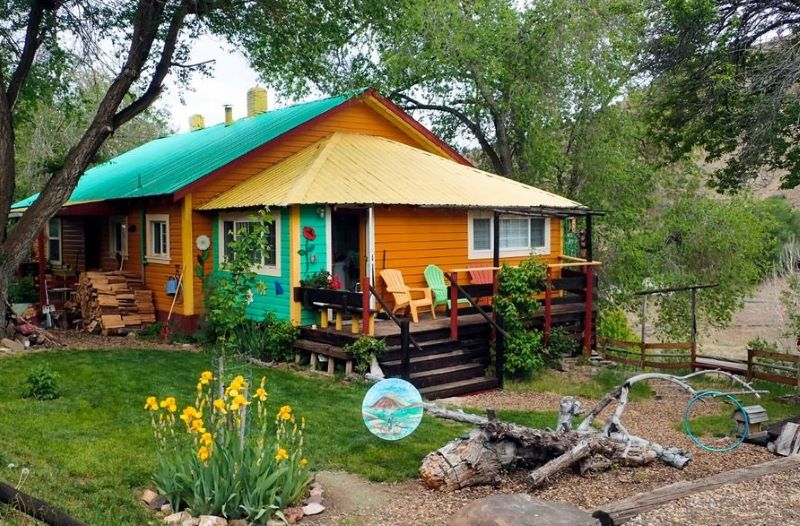
Cycling John Day Fossil Beds
Biking and cycling is a great way to see parts of the monument and surrounding area. There are several route options of different lengths that include both paved and gravel roads.
As described in the sections above, there is ample accommodation for cyclists (e.g., camping and hostels) as it is a popular excursion in the area.
Several popular routes include the Painted Hills Scenic Bikeway, Twickenham Road Ride, and the Old West Scenic Byway.
Planning Tips for Your Visit
- Plan based on your schedule, keep in mind long driving distances.
- Be sure to fill up on gas and snacks where appropriate as services can be sparse.
- Bring lots of sun protection and water as there is little shade in this desert climate.
- Read about the geology and fossils of the area before you go!
FAQ
Can you collect fossils at John Day Fossil Beds?
No! Collecting fossils within the boundaries of the national monument is strictly prohibited. Fossils are protected resources and belong to the public, ensuring their preservation for scientific research and education.
What species are found in the John Day Fossil Beds?
The area within the John Day National Monument has yielded a wide range of fossil species, including ancient mammals, plants, insects, birds, reptiles, and even early horses. Fossils from different time periods reveal a diverse array of life that once inhabited the area.
What are some interesting facts about the John Day Fossil Beds?
- The monument is named after the John Day River, which runs through the area and has played a significant role in the deposition and preservation of fossils.
- It contains one of the world’s most complete fossil records of Cenozoic terrestrial ecosystems.
- Fossils found within the monument date back as far as 44 million years ago.
- The monument encompasses over 14,000 acres of protected land across its three units.
How old are the John Day Fossil Beds?
The fossil beds span a significant period of time, with fossils ranging from about 44 million to 5 million years old, but some rocks are quite older. The monument provides a window into the ecosystems and environments that existed during this timeframe.
Why is John Day Fossil Beds important?
This area is crucial for scientists studying paleontology, as they provide invaluable insights into the evolution of life, ancient ecosystems, climate change, and geological processes. The preserved fossils contribute to our understanding of Earth’s history and the biodiversity that once thrived in the region.
What are the three different parts of the John Day Fossil Beds?
The John Day Fossil Beds National Monument consists of three units: the Painted Hills Unit, the Clarno Unit, and the Sheep Rock Unit. Each unit has its own distinct geological features, landscapes, and fossil record.
How was John Day Fossil Beds formed?
The formation of the fossil beds involved a combination of volcanic activity, sediment deposition, erosion, and climate changes over millions of years. These processes resulted in the preservation of fossils within layers of rock, which have gradually been exposed through natural forces.
What animals were found in the John Day formation?
The John Day Fossil Beds have yielded fossils of various animals, including early horses, oreodonts (hoofed mammals), camels, rhinoceroses, saber-toothed cats, ancient rodents, small carnivores, and numerous species of birds.
How big are the John Day Fossil Beds?
The John Day Fossil Beds National Monument covers a vast area, encompassing over 14,000 acres (about 22 square miles) across its three units: the Painted Hills Unit, the Clarno Unit, and the Sheep Rock Unit. Each unit offers its own unique geological features and fossil treasures.
What city is John Day Fossil Beds in?
The John Day Oregon fossil beds are located in central and eastern Oregon, primarily in Wheeler County. The closest city to the monument is the town of Dayville, and the nearby town of John Day lends its name to the monument.
Conclusion
We hope you found this article helpful. The John Day Fossil Beds in Oregon is a fascinating, unique, and memorable place to visit. Please do your part to help preserve this special place for future visitors.
If you are visiting Central Oregon, welcome! We hope you enjoy your time here. You may be interested in our other articles about Central Oregon including amazing Central Oregon hikes.
You also might want to know some other things to do in Bend.
Also, subscribe to our YouTube and follow us on Instagram for more inspiration for exploring the PNW. Happy roaming!






